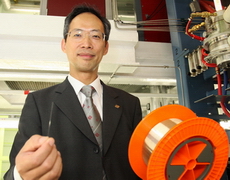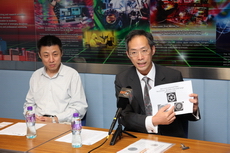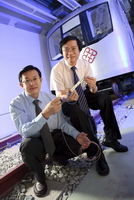|
|
|
|
|
|
|
Fibre optics research in Hong Kong – applications and prospects |
||
Fibre optics research in Hong Kong – applications and prospects
|
Prof. Charles Kao, ‘Father of Fibre Optics’, has become the first Hong Kong scientist to be awarded the Nobel Prize in Physics. More than 40 years ago, he put forward his revolutionary idea about fibre-optic communications, which has shaped the foundations of today’s networked societies. Apart from thrilling the Hong Kong community, the news also leads us to explore the recent development of fibre optics research in Hong Kong. In this issue, Prof. Alex Wai, Dean of the Faculty of Engineering and Chair Professor in Optical Communications, shares his views on the topic. Prof. Wai, who has spent the past 28 years in optical fibre communications research, is one of the two fellows of the Optical Society of America in Hong Kong. Q: What is the recent development of fibre optics research at PolyU? Wai: The development of optical fibre communications has advanced quickly since Prof. Kao’s insight in using glass fibres for optical communications. PolyU’s Faculty of Engineering has recently set up a Specialty Optical Fibre Fabrication Laboratory in its Department of Electronic and Information Engineering (EIE) and Department of Electrical Engineering (EE) to support research work in optical fibre communications and other application areas. Q: What is so special about the Laboratory? Wai: The Laboratory houses an advanced fibre drawing tower, the only one of its kind in Hong Kong, which costs over US$2 million. The fibre drawing tower is capable of pulling the newest type of optical fibres called “micro-structured fibres”. Q: What are the differences between conventional optical fibres and “micro-structured optical fibres”? Wai: The conventional optical fibres that are used today have a solid core and cladding, while micro-structured optical fibres have air holes running along its length. Different arrangement and sizes of the air holes will result in optical fibres with different properties. Q: In what areas could this cutting-edge fibre manufacturing technology be applied? Wai: The technology can be used in communications and sensing applications. Q: Could you cite an example to illustrate the novel use of fibre optics in communications? Wai: Prof. Lu Chao of EIE and his colleagues are developing the next generation high capacity optical communication networks with Huawei Technologies, the leading communication equipment company in the world. The experimental network is capable of a transmission rate of 100 gigabits per second to a distance of more than 1,500 km. Q: Could you also give some examples about the use of fibre optics in sensing applications? Wai: Prof. Tam Hwa-yaw of EE and his colleague Prof. Ho Siu-lau have been working closely with MTR to develop a novel “Fibre Optic Sensor System” for monitoring the train conditions and track activities. They also supported the installation of the system along the East Rail and West Rail, and later the Airport Express Line and the Light Rail. The use of fibre optics has also been extended to the field of construction. Led by Dr Ni Yi-qing of the Department of Civil and Structural Engineering, the team has made use of fibre optics to monitor structural safety for mega-structures like high-rise buildings and long-span bridges. It is being used for the construction of Guangzhou New TV Tower – the highest TV Tower in the world. Q: How do you think about the future development of fibre optical communications? Wai: Mankind’s need to be connected with each other will continue to fuel the demand for faster communication networks. The core or backbone networks will rely on optical fiber technology in the foreseeable future. In the last three decades, the optical fiber transmission speed has increased almost a million times bringing forth the Information Age. I am confident that optical fiber communication researchers will rise up to the challenge and develop faster and better communication networks to bring the world even closer together. Details >>
|
 |
 |
||
 |
||
 |